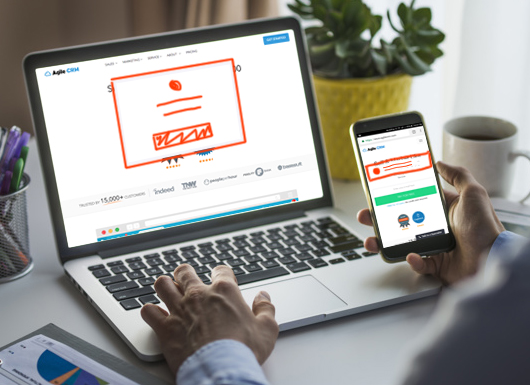How to engage customers and prospects with push notifications
You know those messages that appear on the lock screen of your mobile device? Perhaps alerting you to a new text message? Those are push notifications. They are used to share timely information with prospects and customers. You can leverage push notification messages on either mobile devices, laptops, or desktops to engage customers and prospects. With the use of a push notification service—such as provided in many marketing automation solutions—pushing out alerts is a breeze.
But how do they work and how can you use them to drive higher levels of engagement? Below we’ll take a deep dive into push notifications and discuss some tips for effectively using them.
Opting in
Push notifications are sent for several reasons, but the underlying objective is the same: to convince your prospect or customer to click the notification and take the desired action.
One challenge around desktop and laptop push notifications is that your audience must intentionally opt in to receive them. They navigate to your website, and a web pop-up appears asking if they would like to receive notifications from your site. Clicking yes is opting in, and once they’ve opted in, you can send them push notifications at will. They don’t have to be on your site at the moment the notification is sent; as long as they are online, the notification will appear.
Mobile app push notifications work a little differently. Often, when you download a new app, notifications might be turned on by default. You can turn them off easily, but you’re not normally required to opt in, as downloading the app implies consent.
This poses a challenge, though, as most prospects will not download an app if they are not a customer. This is the case unless your app doesn’t revolve around selling a product or service, but rather providing information. We’ll cover more on this below.
Push notifications vs. web pop-ups

You may be thinking: “yeah, I know about push notifications, I see them pop up all the time on websites I visit, offering me this or that.” However, what you see in that context is a web pop-up, which differs considerably from a push notification.
A pop-up has one objective, to gather prospect information for future marketing. Push notifications come after the data gathering stage. Once you have someone’s personal data—perhaps obtained through a pop-up—you can send them push notifications. If you don’t have their contact info, there’s no possible way you can push a notification to them.
Customers vs. prospects
Customers, as you can imagine, are more likely to opt in for push notifications. It’s probable that they will want to stay up to date on what’s going on with their product or service provider. Also, it’s much more likely that a customer will have downloaded your mobile app, so you have a better chance at engaging customers through mobile push notifications as well.
Prospects, on the other hand, will only rarely download an app for a company they have never purchased from in the past. An exception would be news sites or other brands that only provide information via an app. But in that case, the push notification isn’t sent to the prospect; it’s sent to the consumer of that information. Their true prospects will be those who advertise on their site.
Often, a prospect will be browsing your website and see a pop-up asking if they would like to receive notifications. If they are interested in your product or service, it’s much more likely that they will opt-in to receive push notifications. If not, they won’t. In general, it’s much harder to get prospects to opt into push notifications. But if you do convince prospects to opt in, push notifications are a great marketing tool.
Tips to increase engagement with push notifications

Now that we’ve covered some of the basics of how push notifications work, let’s dig into some tips and tricks that will help you use them most effectively for maximum engagement.
Don’t blanket blast
By “blanket blast” I mean sending the same push notification to everyone in your database. There’s no way any single message would be relevant to your entire constituency unless it’s an offer for free money.
Push notifications need to be relevant to the recipient. If not, you run a high risk of annoying them, and they will opt out. That’s why the best way to excel at push notifications is by personalizing them.
Personalization
Rather than sending blanket push notifications to everyone in your database, look into personalizing them. Personalization in marketing is becoming the norm, and push notifications are no exception.
With all the information stored in your CRM, you can personalize push notifications to a high degree. You can also use system triggers to push a notification when a prospect or customer performs a certain action. To be sure, the best push notification messages are personalized.
In fact, companies that use triggers and personalization in their push notifications can increase notification open rates by as much as 800%.
For example, you can geo-target your push notifications to only contacts in a certain geographical area. You can personalize based on product pages that someone has visited in the past. There is a vast array of ways to get creative with push notifications. Just consider what your audience needs and wants to see, and focus on that.
Reactivate dormant users
Some customers who use your app may go dormant for a while and not use the app for an extended period. Push notifications are a great way to bring them back into the fold. Your marketing automation solution should be able to tell you who hasn’t logged into the app in a while.
You can develop a push notification with new content or some special offer that’s engaging enough to encourage them to start using the app again. In many cases, people have so many apps that they forget about some of them. Push notifications are a great way to put your brand back in the front of their mind and re-engage them.
Push new content
If you have an awesome new piece of content, you can get the word out with a push notification. But again, remember that all your content won’t be relevant to all your contacts. You should be able to use segmentation to identify those that are likely to have an interest in that content and push to them only.
Great, dynamic content will drive them back to your site where they will engage with it. But always remember to segment the recipient list of that notification to ensure it’s timely and relevant to the recipient.
Don’t be too “pushy”
There is a fine line between helpful push notifications and “pushy” notifications. If you push out notifications too often, you will almost certainly start to annoy your audience. A push notification interrupts the day of the recipient, so make sure that when you do push out a notification, that it’s going to add value to their day. Otherwise, you’ll find many people opting back out.
Conclusion
Push notifications, when used right, can engage your audience and drive recurring business, customer satisfaction, and the conversion of leads into new customers. You can use them as one-offs, triggered by certain actions taken by the customer or prospect. Or, you can incorporate them into a multichannel marketing campaign.
Just remember to follow the tips above, and you can hover on the non-pushy side of notifications. Remember to personalize and not send blanket notifications. Armed with these tips, and the basic information about push notifications above, you’ll be sure to find your rhythm and succeed at sending effective, engaging messages at just the right time.
Do you have any anecdotes or suggestions around push notifications? Share them in the comments section below!

4 Comments
Angelita Hahn
about 7 years agoGood Article!!!! i got some information From your article about how to engage people to make customer. Thanks for sharing information !!!!!
ReplyGabriel Swain
about 7 years agoThanks, Angelita! We appreciate the comment and positive feedback. Keep tuning in to stay up to date on trends and best practices. Best of luck!!
ReplyDaniel
about 7 years agoRohit, thanks for your summary, you covered the main tactics in successful pushes I believe. My position is the same as yours - I believe that push notifications are useful and great until you become too pushy or spamming your customers with unnecessary content. Recently I was directed to meaningful blog post related to web pushes https://getfirepush.com/blogs/news/web-push-notifications-acomplete-beginners-guide, what's more I discovered updates on researches that enhance about emojis great impact in marketing personalization http://www.lulu.com/blog/2018/07/16/get-personal-using-emojis-to-personalize/ So I strongly believe that this updates could help in developing any ecommerce business aimed to customer category 15-45 years old, that uses mobile apps daily. What do you think of smiles/gifs/emojis and stuff? And what about the others? Did you feel any result of using interactions in your content?
ReplyRohit Munipally
about 7 years agoHi Daniel, Push notifications do become spam when they are too often which makes the customers block them. I personally do it. Using the emojis/smileys and stuff does make it more lively for interactions, especially on the e-commerce websites. Always, having the right messaging at the right time helps improve customer engagement and satisfaction levels.
Reply